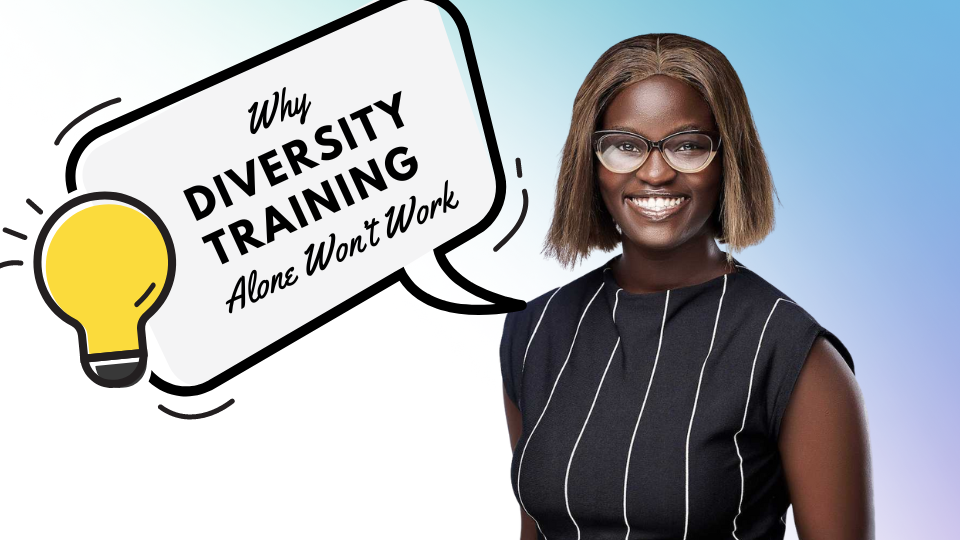Diversity and inclusion training have become increasingly important topics in the workplace. In the US, 99% of Fortune 500 and 50% of mid-sized organizations have implemented diversity training programs to promote a more inclusive culture. In Europe, more and more companies also choose to use diversity trainings as a start. However, research has shown that traditional and online diversity and inclusion training programs have limitations and may not produce significant or lasting changes in attitudes and behavior towards diversity and inclusion.
Limitations of Diversity Training
In the study Why Diversity Programs Fail by Frank Dobbin and Alexandra Kalev from Harvard University, the authors reviewed 31 years of research on diversity training programs and found that traditional diversity training programs tend to be ineffective at promoting diversity and inclusion in the workplace. Here are some of the specific limitations of diversity training that the study highlighted:
- Limited Duration: The study found that most diversity training programs are one-time events that typically last between two hours to a full day. This limited duration may not be enough time to create significant or lasting changes in attitudes and behavior towards diversity and inclusion.
- Focus on Awareness Rather Than Action: Many diversity training programs focus on raising awareness of biases and stereotypes but do not provide employees with actionable strategies to address these biases in their daily work. This can limit the impact of these trainings, as employees may not know how to put the strategies they learn into practice.
- Resistance to Training: The study found that some employees may feel resistant to diversity training programs, particularly if they feel like the training is mandatory or if they perceive it as an attack on their own beliefs or attitudes. Especially when employees are exposed while learning about their unconscious bias, many fall into the defensive. The learning effect decreases.
- Lack of Focus on Specific Diversity Issues: Inclusion and diversity training programs that take a broad approach to diversity may not be as effective as those that focus on specific issues that are relevant to the organization. For example, diversity and inclusion training topics that focus on addressing biases towards women may be more effective in a company where there are few women in leadership positions than in a more general diversity training program.
Language as the Solution for Sustainable Inclusion Learning
In order to be effective, diversity and inclusion training needs to be repetitive, at a low threshold, and happen in a safe learning environment. A company culture can only be changed sustainably if all current and new employees and leaders are consistently and repeatedly trained. Also, employees can only be made aware of their own unconscious bias with ongoing hints. Finally, employees shouldn’t be exposed when learning about their biases.
These are all requirements that diversity trainings can’t fulfill.
- Repetition and scaling diversity trainings throughout the whole organization are too costly.
- Bias awareness can’t be trained in one-off workshops. Making people aware that such unconscious bias exists, won’t make them less biased. After such a workshop, they know what unconscious bias is, but they won’t be able to detect it in their behavior. Worse: Many think that by knowing what it is, they can detect it. They then fall into the trap of over-confidence bias. And that even has a counterproductive effect on their behavior.
- Acknowledging to oneself that we are biased is not an easy task. Because non of us want to be biased. When we get confronted with our bias in a room full of people, we feel exposed; it’s embarrassing. We often even fall into the defensive. By doing so, we close ourselves, unintentionally, to learning.
So, how can we still train employees and leaders on inclusion without falling into the ‘diversity training traps’? Inclusive language software can help.
Unlike diversity trainings, language is an everyday tool - especially since we all work more remotely. We communicate in written form all the time. Language is the perfect tool onto which we can hook diversity and inclusion training without the above-mentioned flaws of diversity trainings.
Inclusive Language Builds Inclusive Culture
Language builds culture. Inclusive language builds inclusive culture. Thus, providing employees with a simple solution for inclusive language can address the limitations of traditional diversity training. Inclusive language software enables organizations to build an inclusive culture sustainably. How?
- Software like Witty is integrated into the writing flow of employees, analyzing what’s being written while respecting privacy
- It detects biased wording - conscious and unconscious - in real time.
- With short, entertaining learning bites, writers get educated about the bias behind the word.
- Then, they are provided with suggestions for alternative language choices, which they are free to accept.
Neither diversity trainings nor inclusive language software should force people to be more inclusive. Because the above-mentioned study has shown that mandatory training doesn’t help.
Very importantly, using software we are able to measure behavior. Unconscious bias can’t be measured when doing surveys with employees. Because it is - by definition - unconscious. The answers we get in surveys are what people think of themselves, but not how they truly behave.
With Witty, we are able to measure unconscious bias in communication. And since language is an expression of how we were socialized, we can, through measuring communication, actually measure unconscious bias and the bias traps that employees fall into. A tool like Witty finally makes it possible to produce tangible data on unconscious bias.
Moreover, what has been experienced by customers: Witty not only makes employees more productive in Inclusive Language and more aware of bias in language, but it also positively influences their everyday behavior. The learnings they made in writing, they bring to the coffee machine or to lunch. They show a more inclusive behavior in non-digital interactions. This greatly fosters the efforts of organizations towards a culture of inclusion.
By focusing on inclusive language, companies can, on the one hand, provide employees with practical guidance on how to communicate in ways that are respectful and welcoming to everyone. On the other hand, employees develop a habit of being more bias aware and behave more inclusively, leading to a more inclusive workplace culture.
Overall, while traditional diversity training can be helpful in raising awareness about biases and promoting inclusivity, incorporating inclusive language into the workplace can provide employees with concrete strategies to promote inclusion and address biases in their daily work.
Combining Diversity Training with Tools like Witty
Traditional diversity training programs are often limited in their effectiveness, as they primarily focus on raising awareness of biases and stereotypes without providing actionable strategies to address them. However, by combining diversity training programs with tools like Witty, companies can help employees put their learning into practice in their daily work.
Witty helps to reinforce the lessons of diversity training because it provides immediate feedback to employees when they use biased language. This feedback is crucial, as it helps employees to recognize and correct their biases in real-time. The immediate feedback also allows employees to practice bias awareness and inclusive behavior in their daily work, which can help to create a more inclusive workplace culture over time.
This approach helps to bridge the gap between awareness and action, which is often a challenge in traditional diversity equity and inclusion training programs. By providing employees with a concrete tool to help them practice inclusive behavior in their daily work, companies can help to create a more inclusive workplace culture. This, in turn, can lead to better employee engagement, increased productivity, and improved business outcomes.
Conclusion
Traditional diversity and inclusion training courses have limitations, but they can be supplemented with tools like Witty. This combination can help employees apply the strategies they learn in diversity training to their daily work, promoting a more inclusive workplace culture and creating a better environment for all employees.








